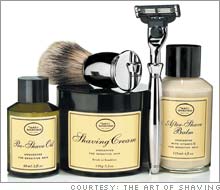|
The Art of Shaving's strategy: A cut above By combining nostalgia and know-how, this luxury retailer is capitalizing on the men's grooming boom.
(Business 2.0 Magazine) -- The Manhattan block that houses the Art of Shaving's flagship store is a preppy paradise. The main Brooks Brothers store is down the street, the Yale Club just around the corner. Inside the boutique, barbers wield horn-handled straight razors and badger-hair brushes, then soothe customers' faces with post-shave clay masks.
An hour later the newly shaven emerge with shopping bags full of sandalwood-scented aftershaves, lemony pre-shave oils, and nickel-handled razors, hoping to re-create the experience at home. Part barbershop and part pampering spa, the Art of Shaving is pouncing on the fast-growing men's grooming trend by appealing to consumer nostalgia. Its 10 retail outlets - five of which have onsite barbers - are dedicated to making men better shavers by getting them to trade in their Barbasol. Though several premium shaving brands have emerged during the past few years, the Art of Shaving is by far the most successful. Last year the company booked a 15 percent net profit margin on more than $15 million in sales - half of which came from upscale department stores like Neiman Marcus - pulling past hipper brands like $3 million Sharps Barber & Shop and traditional lines like Truefitt & Hill. Turning a habit into a ritual Now, with plans to open 40 more U.S. stores during the next two years, husband-and-wife founders Eric Malka and Myriam Zaoui think the Art of Shaving's retro appeal can easily win over mainstream buyers. "You'd be surprised how often customers refer to their fathers and grandfathers," Malka says. "That's as emotional as it gets." Even as the men's grooming market grows at a double-digit clip - sales of prestige skin-care products rose 14 percent to $70 million in 2005 - the Art of Shaving has averaged 30 percent annual sales growth throughout its decade-long existence. This year the company expects to continue at that pace even as it expands, opening 300- to 1,800-square-foot stores in cities such as Atlanta, Chicago, and Dallas. With the expansion, the Art of Shaving's real competition will become drugstore brands from the likes of Procter & Gamble (Charts). "The shaving industry was only a mass market before we arrived," Malka says. That's why a major piece of the Art of Shaving's sales strategy is education. "Seventy-five percent of the men who come to our shops have shaving discomfort," notes Zaoui, an aromatherapist who oversees the company's product development. So it's up to the sales staff to teach customers how the Art of Shaving's product-intensive regimen can soothe their irritation (see "The Four-Step Shave," below). Though the new boutiques won't feature barbers, the sales force will have the time and the mandate to educate consumers in a way that the staff of Neiman Marcus or Barneys doesn't. Karen Grant, a beauty industry specialist at research firm NPD Group, likens the strategy to that of MAC and other cosmetics brands, which teach customers how to use makeup and sell them products to replicate the process at home. "Education has been very successful on the women's side," Grant says. "If the Art of Shaving is creating an in-store experience to do that for men, they could be very successful." Of course, there are risks involved, including higher overhead and more intensive sales training. But Malka isn't worried. "In a department store like Nordstrom, where we do really well," he says, "we only have 3 square feet." Even a shaving brand needs a little room to grow. The four-step shave The Art of Shaving's lengthy regimen involves several super-premium products. It's no surprise that the average customer's order is $100. 1. Prepare Scented oil ($22) lubricates and protects the skin. 2. Lather Up Badger-hair brushes ($50 to $1,200 for a silver-handled version) are used to apply shaving soap ($40) or shaving creams ($22). 3. Shave Razor prices begin at $30 and go as high as $1,000. All razors are designed for use with Gillette blades. 4. Moisturize Shoppers can choose from aftershave balms ($38), clay masks ($65), face wash ($22), and moisturizer ($35). Greg Lindsay is a freelance writer based in Brooklyn. |
|

